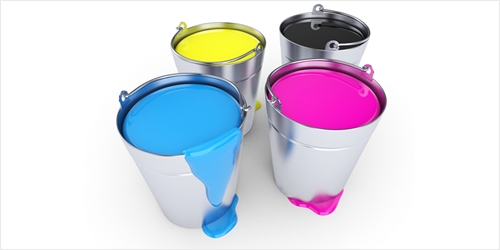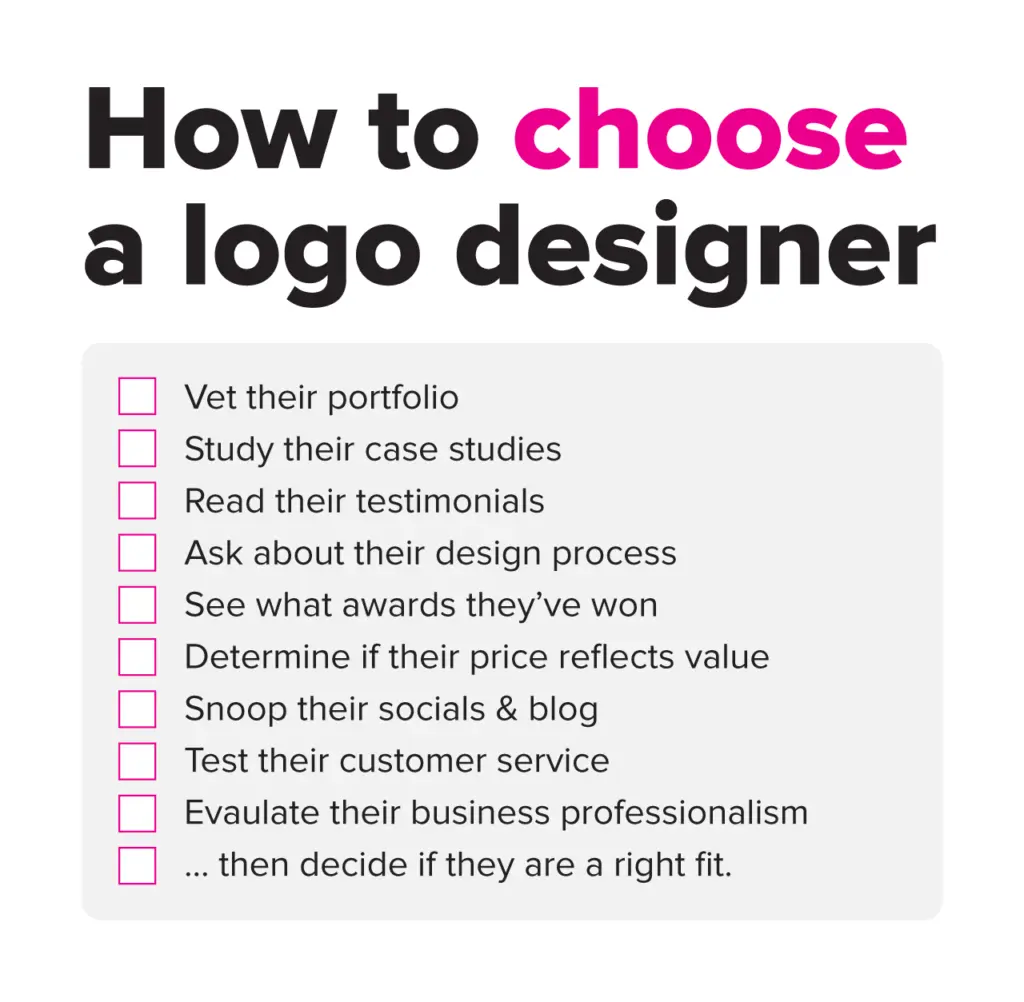With such a plethora of choice it may be hard to find the right designer for your specific needs. Below is a short guide to help you make the right choice when choosing a logo designer. These points could also be useful when hiring a web designer, graphic designer, or any designer for that matter.

I don’t want this post to come across as self promotional, however, I’ve linked to my own examples to show you how I personally communicate to potential clients the value of my design work. For other designers, I hope this in turn, gives you an idea of how you too can communicate the value of your work.
In no particular order:
1. Experience
Previous identity projects will give you a good idea of what skill level your designer is at and what you can expect though this is not to say that a new designer can not produce top quality results – this point has to be considered with all of the other points mentioned below, in which case a strong portfolio is probably the best indicator.
For examples of some quality identity design, please check out Logo Of The Day, where Jeff Fisher and I feature a new talented logo designer every day.
2. Positive Testimonials
Have they got positive testimonials from past clients and colleagues?
Ensure you check the testimonials validity which can be done by looking for a web address or even by emailing the company. It’s a good idea to check if the company even exists.
3. A Thorough Design Process
Do they have a logo design process in which they follow or are they simply producing logos like fast food? A typical process does not take under 48 hours to complete which is why I wrote the article How NOT To Design A Logo which tells you to avoid design contests, logo factories, etc.
Think for how long your logo design will be in use – would you want that to be designed (let alone researched) in under 48 hours? Logo design is not a take away food store and this is why logo design does not cost $5.00.
There is no ‘typical’ time frame as every client will have different needs but for small and medium businesses a rough guide would be around 2 – 6 weeks.
4. Awards Won / Published Work
Have they won any awards for their work? Is their work published in any books or magazines? How recognised are they in the industry?
5. A Strong Portfolio
How strong is their portfolio? What is the make up of real to ‘fake’ logo designs? When I say ‘fake logos’ I refer to the logos made for fictional companies, rather than for real clients.
6. Price
The costs of the service is usually quite evident of what you are going to receive. In most cases, you will get what you pay for but don’t take price as the only indication.
How much does a logo design actually cost? In my experience, this is the most frequently asked question and the hardest to answer. This is because every company has different needs… the best approach is to draw up a customised quote for each individual client.
7. Design Affiliations
Are they affiliated with any design associations or publications? This is a good indication of how dedicated they are to their craft though is not at all essential.
As an example, I am a member of NAPP – The National Association of Photoshop Professionals and Logo Lounge, an online gallery for logo design professionals. Other affiliations could be AIGA, HOW or even a local design group.
8. Great Customer Service
Do they respond to your emails quickly? How do they communicate & present themselves? A designer should provide great customer service throughout the whole process, from the initial email right through to after sales support.
9. Business Professionalism
Attention to detail, trustworthiness, strong communication skills and time management are all vital and go hand in hand with great customer service.
10. Appropriate Questions
A designer should ask a variety of questions to find out your needs in relation to your business goals. Questions should revolve around the companies history, target market, competitors, company goals, etc. For an example of the questions asked, check out my logo design questionnaire.
In summary
These are 10 things you should take into account when choosing a logo designer:
- Proven Success & Experience
- Positive Testimonials
- A Thorough Design Process
- Awards & Published Work
- A Strong Portfolio
- Price
- Design Affiliations
- Great Customer Service
- Business Professionalism
- Appropriate Questions
Do you have any further points to add?
Images courtesy of Shutterstock.




I like how you call out the process as an essential part of the vetting process when looking for a logo designer. This is something I recently discovered, when cruising around job boards looking to fill up the gaps. Having some initial difficulty explaining to the Craigslist crowd that a logo designed by me would cost several times more than the next cheapest competitor, I referred to my experience in creative process and art direction. In citing some specific examples of how the process worked (last 4 clients have accepted the first showing with zero revisions, for one), I have been able to overcome the McDonald’s Design crowd issue.
I’ve saved this post to use as a checklist to improve my marketability. Thanks for another great article.
I think you’re right again! For me, none of these 10 points are less important or wrong! This should be used as a “customer guide” for sure! 😉 Thanks for another great and useful reading!
Nice post, but I don’t see them working because they always chose the same one… ME!
have a nice day Jacob!
Hi Jacob
These are all good points, especially explaining why it shouldn’t be a quick fix process. One minor quibble that’s always bugged me, and that’s the “proven track record”. I now have one thankfully, but everyone starts somewhere and there’s no reason a relatively young designer couldn’t produce top quality work (not all graduates could, obviously) if they know what they’re about. I suppose it depends how confident the client is in managing their end of the design process and articulating what they want and the designer is confident in interpreting this and presenting his/her workin a professional way.
Hey I’ve been going through you site and I have to say it’s really great! There’s a lot of helpful information for a new designer like myself. But I have to agree with Paul on the whole track record thing. I don’t have a lot of clients but the ones I do have like my work. I also have a lot work that I did in school and for free for friends. Which I noticed that you had an area of your site for that. Like I was saying your information is great and I am really impressed with the quality of your work… Thanks for taking the time to help us newbies out and educating everyone else on this awesome growing profession.
Good points for an experienced designer like yourself but like the few posts above, everybody has to start somewhere. I know this article is about logo design but do these also apply to other design areas as well?
Very useful Jacob, you mention very important points! Thanks again!
Very good list. Hopefully one day I will be as successful as you are 🙂
Nice post Jacob, reading this I was wondering about how designers pay their taxes, there are a lot of freelancers out there… I guess it’s a different story in every country. Let me suggest you this topic for a new post in the future.
Thanks!
I’m a graphic designer, so if I ever needed to choose a designer it would be to work alongside me on a particular project.
So what i’d be looking for most of all would be a highly commendable, almost bullet proof, portfolio of work.
This should include case studies and projects that have delivered above and beyond what the client originally required. Final solutions that produce improved end-results for that person/company in both the short and long term. This should combine any professionalism, track record and experience issues you may have.
If the guy can play then he/she gets the gig.
Price is the only other thing that I would look at. Everything else is just window dressing.
Bryan,
Educating the client is always going to be one of the tasks of the designer, which is one of the reasons I am not a huge fan of the crowd sourcing sites that devalue the value of design. Good to hear your work is getting approved so easily.
Paul, Hanan,
I updated the post, I was naive in not mentioning this fact – everyone does have to start somewhere.
Kiren,
Yes, these can be applied to other areas of design as well, or any freelancer for that matter. Also see my comment above.
Abbas,
But if you have two potential designers with similar traits and one has the window dressing, whom are you going to choose?
Carlos,
That is a good topic, but like you suggest the laws are so different in each country, let alone states. I would recommend seeing your local tax office for advice.
I do agree with all the points except the the point 6. Price as what I believe you cannot compare quality with cost. What do you say?
Great tips, the hardest part I find is actually finding portfolios to browse! Do you know of any sites that have alot of logo designers?
Good point Kiren!
You always have to start from somewhere. As a beginning graphic designer like me, I need to focus on different things which I can provide to my customers. Building strong brand and potential customer trustfulness is a long process. The most important in my opinion is to provide quality services and tailor them accordingly to each customer.
haha i like the headings of all your blog posts. quite refreshing i must say.
anyway personally i feel today’s designer do a lot of design work across the board (depends on their skill sets) so it there such a thing as a logo designer in today’s cut throat’s market?
@Jacob
I’d go for the one without the window dressing, they’ll be cheaper.
But why do you think about this : ” Do cheap work to build a good portfolio, lets say 70US$ but do your best” How can I raise my prices if I don’t have clients? and what’s the problem with making fakes works? it doesn’t matter if is fake, what it matters is the quality.
cheers.
Unfortunately for new companies, price is such a big factor in choosing.
Thank you Jacob for this nice article as always.
#6: some of the clients don’t want to believe that what they pay is what they get, or they know that is true in their subconscious but choose to ignore it because it is they’re money.
Of course the designer need to now either what he can offer, and to know the market.
It is really hard to find a good logo designer, your tips will help someone who want designer.
I didn’t realise how hectic it would be to find someone to design my logo. Will keep your tips in mind when choosing a designer. Cheers
Hi Jacob,
Your entire site and articles are extremely helpful, and I completely agree that you get what you pay for in this and any industry.
Considering this article about how to choose a good logo designer, could you offer insight as to how one might represent themselves as a worthwhile designer when just starting out on their own?
I have been in my current position for nearly 14 years in the IT industry working for a manufacturer and early on I developed a graphics department within my own department for them so we could produce our own in house graphics to cut costs. Since graphic design has always been a passion of mine, and I was fairly good at it, it became the focus of my job here. I have taken many courses for graphic design, concepts and layout as well as learned much on my own over the years and and have used those skills to provide branding, marketing and catalogue materials for not only my company but also our customers as part of our point of sale product programs we offer them. (We are an apparel company.)
I’ve recently decided I would like to branch out on my own in graphic design but my dilemma lies in the fact that everything I have designed over the last 14 years does not belong to me as being the “designer” and therefore I am not allowed to use it as part of a portfolio. So I am essentially starting with nothing, unless I were to fabricate some designs to showcase my skills.
How would someone like myself garner the trust of first time clients in order to begin building my individual portfolio?
Any comments or suggestions would be greatly appreciated!
~Samantha
I’d love for my clients to read this. Most of them want the work to be quick, cheap and glorious 🙂
Thanks for mentioning such useful points. I believe that the factors like professionalism, testimonials, portfolio, reputation and obviously the price package are very important to choose a good logo designer.
Thanks for this interesting post! I think that a strong portfolio is very important to know how a designer work!
some really important and useful points are mentioned in this article.your tips will help people in finding the appropriate logo designer.
Jacob, it is necessary to win an award? I don´t think so, people can charge good price without having an award.
And what´s the problem with fake logos? It doesn´t matter if is fake, what it matters is the quality, the process, AND specially if there is no client is a good way to show samples.
Diana,
Not crucial but it helps in having ‘official’ recognition. I use that term very loosely. I’ve discussed fake logos before here on JCD, let me know your thoughts after.
I was reading this article and was thinking God, how I could get satisfied if JCD did my logo!
I was reading your article and it really give me ideas what are the things to do when choosing a logo designer.
Thank for this article.
These points could also be useful when hiring a web designer, graphic designer, or any designer for that matter.
Excellent article, Selecting a good logo designer will not be a difficult process if you follow the tips that are enclosed in this blog post. In my view point, the previous work and reviews of the clients bring the right picture of the designer that helps you to choose a right logo designer.
Great informational resource! All these mention points are consider really important factors for choosing a professional and experience logo designer. When ever you are going to choose a logo designer analysis all these points.
In today’s business world, the correct advertisement is one of the key essentials to getting a business recognized, but like requiring a tree before you have the paper, businesses will seek the correct company to supply the design and paper quality before the idea meets its advertising life. Printleaf is that company who lives to promote other businesses, provide quality invitations to meetings or weddings, and overall meets all Large Vinyl Banner, Flyer, and Brochure needs.
the right advertisment is key exactly.
http://www.abbeycarefoundation.com/
Unbelievably user friendly website. Astounding details offered on few clicks.|
csgo skins sites http://springagatha.bcz.com/2016/04/18/the-easiest-way-to-get-nba-2k16-coins-a-fast-quide/